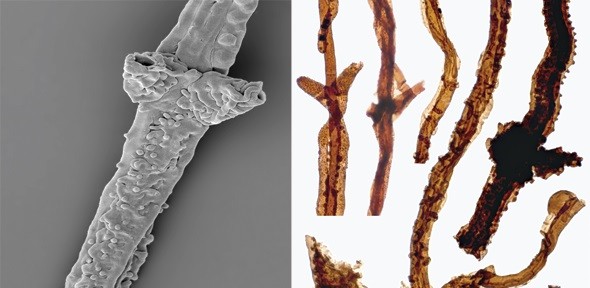By Ana Verayo, | March 05, 2016

The oldest land dweller to be found is a fossilized fungi known as Tortotobus from the Paleozoic era.
A fossilized fungi specimen was unearthed in Scotland from the Paleozoic era, that is apparently estimated to be 440 million years old, as scientists also consider it as one of the oldest samples of fungus fossils.
It is also the oldest sample of a fossilized specimen from a terrestrial organism or the oldest land creature on record, since the oldest ever found on record were fossils of sea creatures.
Like Us on Facebook
According to lead author of the study, Martin Smith from University of Cambridge, most life during ancient times were restricted to ocean life, which is also the time when this fungus existed. Sea organisms are usually limited to lichen like plants and moss type ones that are still evolving at the time.
Before the existence of trees and flowering plants, Smith reveals that the only process for plant life that existed during that time involves rot and soil formation. This fungus, known as the Tortotubus, was tiny yet was very crucial in the rotting process, as it allowed plants to flourish on land, as animals migrated to dry land.
In this new study, Smith and his team attempted to reconstruct the process of this fungi growth for two different fossils that were uncovered decades ago. These fossils were first thought to be different organisms but Smith revealed that they are actually just one organism that were happened to be found during different stages of their development.
The Tortotubus fungi possessed cord like arms that extend from the main organism where its arms are believed to help in colonizing the surface of land. These samples were found from the Scottish Inner Hebridean Island of Kerrera in Sweden, where this fungus is smaller than the width of human hair.
Primordial fungi like the Tortotubus triggered rot and soil formation processes as they sucked in nitrogen and oxygen into the soil. As the fungi decompose, they begin converting compounds with nitrogen derived from animal and plant waste, into nitrate form again. When these are added into the soil, they are absorbed by plants once more.
Today, there are many modern day fungi species that are similar to the Tortotubus which are crucial to the decomposition process in order to move and transfer nutrients in the soil.
Smith and the team says that this fossil reveals the ancient process of complex fungal behavior in the earliest terrestrial ecosystems during early life on Earth. The team also says that this fungi used bacteria or algae on land to begin its first rotting process on land, however these organisms are extremely rare on fossil records.
This new study is published in the Botanical Journal of the Royal Linnean Society.
-
Use of Coronavirus Pandemic Drones Raises Privacy Concerns: Drones Spread Fear, Local Officials Say

-
Coronavirus Hampers The Delivery Of Lockheed Martin F-35 Stealth Fighters For 2020

-
Instagram Speeds Up Plans to Add Account Memorialization Feature Due to COVID-19 Deaths

-
NASA: Perseverance Plans to Bring 'Mars Rock' to Earth in 2031

-
600 Dead And 3,000 In The Hospital as Iranians Believed Drinking High-Concentrations of Alcohol Can Cure The Coronavirus

-
600 Dead And 3,000 In The Hospital as Iranians Believed Drinking High-Concentrations of Alcohol Can Cure The Coronavirus

-
COVID-19: Doctors, Nurses Use Virtual Reality to Learn New Skills in Treating Coronavirus Patients







